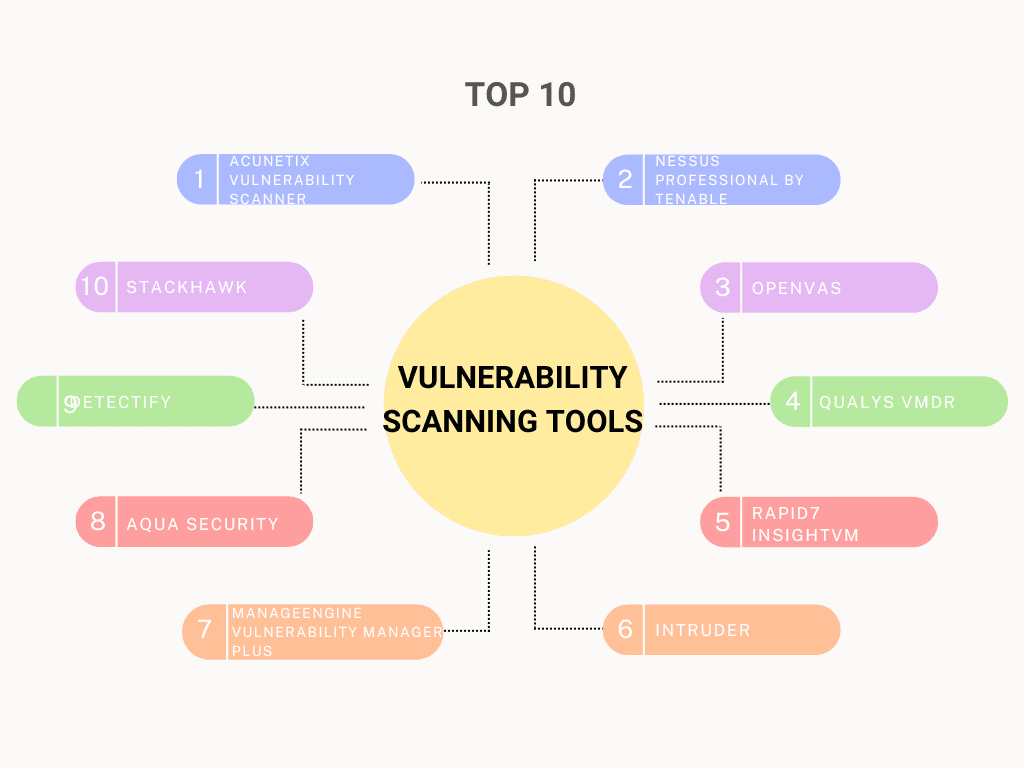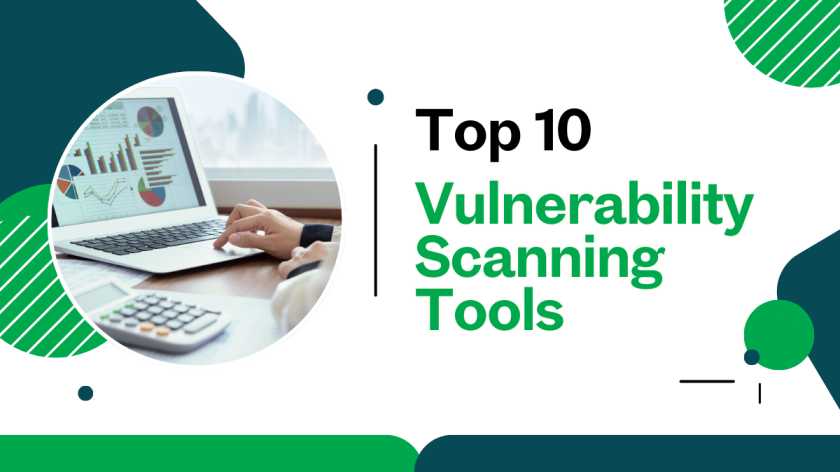Table of Contents
Last updated on September 25th, 2024 at 11:46 am
Vulnerability scanning proactively identifies weaknesses in your systems, akin to inspecting any other defence systems for hidden loopholes and vulnerabilities before attackers exploit them. Unpatched vulnerabilities are entry points for cyberattacks, potentially leading to data breaches, financial losses, and reputational damage.
Choosing the right vulnerability scanning tools is crucial, as different tools excel at specific areas like web applications or network infrastructure. A well-suited scanner strengthens your overall cybersecurity posture.
Adapting to the Evolving Threat Landscape With Vulnerability Scanning Tools
The cyber threat landscape is a constant arms race. Attackers develop new exploits, particularly zero-day vulnerabilities unknown to security vendors. Effective vulnerability testing tools need to adapt by:
- Regularly updating vulnerability databases: Scanners should incorporate the latest vulnerability information to identify even recently discovered weaknesses.
- Leveraging threat intelligence: Integration with threat intelligence feeds allows vulnerability assessment tools to prioritise vulnerabilities based on exploit likelihood and potential impact.
- Utilising advanced scanning techniques: Techniques like fussing and behavioural analysis can help uncover even zero-day vulnerabilities by probing for unexpected system responses.
Vulnerability Prioritisation: Making Informed Decisions
Not all vulnerabilities are created equal. Effective vulnerability testing tools can prioritise identified weaknesses based on severity, exploitability, and potential impact. This helps security teams focus on patching critical vulnerabilities first, optimising their remediation efforts.
Scanners might employ scoring systems that consider factors like:
- CVSS (Common Vulnerability Scoring System) score: An industry standard rating the severity of a vulnerability.
- Exploit availability: Whether a publicly known exploit exists for the vulnerability.
- Affected systems: The number and criticality of systems impacted by the vulnerability.
You can enrol in a comprehensive cybersecurity course to learn how to effectively use vulnerability scanning tools.
The Top 10 Vulnerability Scanning Tools for Shielding Digital Assets

Choosing the right vulnerability scanner is essential for protecting an organisation’s digital assets effectively. Using the wrong vulnerability scanning tools can lead to failure in stopping a cyber attack. Here is a breakdown of the top 10 vulnerability scanning tools, highlighting their strengths and considerations to help you pick the optimal defender for your digital fortress:
A. Acunetix Vulnerability Scanner
- Features: Web application scanning (DAST), extensive vulnerability coverage, compliance checks.
- Strengths: User-friendly interface, in-depth scans for web applications.
- Considerations: Cost-prohibitive for some, complexity might deter beginners.
B. Nessus Professional by Tenable
- Features: Comprehensive scanning for networks, web applications, and configuration assessments.
- Strengths: Integrates with other security tools, robust feature set.
- Considerations: Free version has limited functionality, paid plans can be expensive.
C. OpenVAS
- Features: Open-source and free, extensive plugin library for various scanning needs.
- Strengths: Large, active community for support, highly customisable.
- Considerations: Steeper learning curve, requires technical expertise to manage effectively.
D. Qualys VMDR
- Features: Cloud-based deployment for easy access, patch management and automated remediation.
- Strengths: User-friendly interface, simplifies vulnerability management.
- Considerations: Subscription-based pricing, might not be ideal for strictly on-premise environments.
E. Rapid7 InsightVM
- Features: Agent-based and agentless scanning options, vulnerability prioritisation with threat intelligence integration.
- Strengths: Scalable for large environments, prioritises critical vulnerabilities for efficient remediation.
- Considerations: Resource-intensive for agent-based scans, complex configuration for extensive deployments.
F. Intruder
- Features: Continuous network vulnerability scanning, vulnerability assessments after infrastructure changes.
- Strengths: Proactive approach, minimises vulnerability windows.
- Considerations: Primarily focused on network security, limited web application scanning capabilities.
G. ManageEngine Vulnerability Manager Plus
- Features: Comprehensive vulnerability management for networks, web applications, and endpoints.
- Strengths: Cost-effective solution for SMBs, user-friendly interface with reporting functionalities.
- Considerations: Feature set might be less extensive compared to high-end enterprise solutions.
H. Aqua Security
- Features: Focuses on cloud-native and container security with vulnerability scanning and posture management.
- Strengths: Deep integration with containerised environments, ideal for DevOps workflows.
- Considerations: Primarily caters to cloud-based deployments, might not be suitable for traditional on-premise environments.
I. Detectify
- Features: Continuous web application security testing (WASM), focuses on identifying business-critical vulnerabilities.
- Strengths: Focus on real-world exploitability, prioritises vulnerabilities based on potential impact.
- Considerations: Primarily targets web application security, limited network or endpoint scanning capabilities.
J. StackHawk
- Features: Developer-friendly vulnerability scanning for web applications, integrates seamlessly with CI/CD pipelines.
- Strengths: Simplifies security integration for developers, automates vulnerability detection in the development process.
- Considerations: Primarily focuses on web application security during development stages, might not be suitable for comprehensive post-deployment vulnerability management.
Choosing the Right Vulnerability Scanning Tools
Forget feature overload. Selecting the ideal vulnerability scanner goes beyond a laundry list of functionalities. Here is a framework to guide your decision based on your specific needs:
Deployment Type
Cloud-based vulnerability scanning tools offer ease of use and scalability, while on-premise options provide greater control. Hybrid environments might require scanners compatible with both deployments.
IT Expertise
User-friendly interfaces and intuitive dashboards are crucial for teams with limited technical knowledge. Conversely, advanced users might prioritise extensive customisation options.
Budget
Open-source and freemium vulnerability scanning tools offer a cost-effective entry point, while paid solutions often provide more comprehensive features and support.
Do not operate in silos. Integrations with security information and event management (SIEM) systems or ticketing platforms can streamline vulnerability management by automating workflows and enriching threat context. You can also consider using VMPs that go beyond basic scanning. These platforms offer comprehensive vulnerability management, integrating scanning with features like patch management, reporting, and threat intelligence for a holistic security posture.
The Future of Vulnerability Scanning Tools
The vulnerability scanning landscape is constantly evolving. Here is a peek into what the future holds for vulnerability scanning tools:
- Cloud-Based Dominance: Cloud-based vulnerability scanning tools are poised for even greater adoption due to their ease of use, scalability, and centralised management capabilities.
- Continuous Scanning for Real-Time Defense: The shift towards continuous vulnerability scanning will become more prominent, enabling near real-time detection of emerging threats and faster response times.
- AI and Machine Learning Take Center Stage: Artificial intelligence (AI) and machine learning (ML) will play a more significant role. Vulnerability scanners will leverage AI and ML for advanced threat detection, vulnerability prioritisation, and even automated remediation strategies.
Wrapping Up
Vulnerability scanning is an essential shield in today’s cyber battlefield. It empowers you to proactively identify weaknesses before attackers exploit them. Remember, the “best” vulnerability scanner isn’t a universal solution. You should carefully consider your specific needs and choose a tool that seamlessly integrates with your environment.
With the power of vulnerability scanning and robust vulnerability management practices, organisations can build a formidable defence and ensure the long-term security of their digital assets. Want to learn how to defend organisations against cyber threats and explore advanced cybersecurity practices? Enrol in the Advanced Certificate in Cybersecurity and Blockchain By E&ICT IIT Guwahati. This holistic cybersecurity course will prepare you for a solid career in cybersecurity.
Frequently Asked Questions
What is the difference between vulnerability scanning and penetration testing?
Vulnerability scanning is an automated process that identifies weaknesses in systems. Penetration testing simulates real-world attacks to exploit those vulnerabilities and assess your overall security posture. Both are crucial for a layered defence.
Are free vulnerability assessment tools any good?
Free vulnerability testing tools can be a great starting point for smaller businesses or personal use. They might have limitations in features or scan depth compared to paid options. Consider your needs and weigh the features against the cost.
How often should I scan for vulnerabilities?
The frequency depends on your industry, risk tolerance, and how often your systems change. Regular scans (weekly or monthly) are ideal, with additional scans after system updates or security incidents.
Are vulnerability assessment tools enough to secure my systems?
Vulnerability scanning is a vital first step, but it is not a silver bullet. You need to implement vulnerability management practices like prioritisation, patching, and retesting to ensure vulnerabilities are addressed and don’t linger.

